In today’s digital age, a well-designed website is crucial for any practice in the chiropractic industry. A website is often the first point of contact between a chiropractor and potential patients. Therefore, having a patient-focused website design can significantly enhance user experience, build trust, and improve conversion rates.
In this article, we will explore 9 examples of chiropractic websites that prioritize patient-focused design and discuss best practices for creating an effective chiropractic website.

Why Patient-Focused Design Matters
Enhancing User Experience
A patient-focused website design is essential for enhancing user experience. When potential patients visit a chiropractic website, they should be able to navigate easily and find the information they need quickly.
A well-designed website improves navigation, making it easier for users to browse through services, read about the chiropractor, and book appointments. This not only enhances user satisfaction but also increases the likelihood of patients returning to the website.
Building Trust and Credibility
A professional and patient-focused website design builds trust and credibility with potential patients. First impressions matter, and a clean, well-organized website can convey a sense of professionalism and care.
Features such as patient testimonials, detailed information about the chiropractor, and educational content can help build trust and establish the chiropractor as a credible and reliable healthcare provider.
Improving Conversion Rates
Effective website design can lead to higher conversion rates. Clear call-to-actions (CTAs), easy-to-find contact information, and streamlined appointment booking processes make it easier for potential patients to take the next step.
By focusing on patient needs and providing a seamless online experience, chiropractors can increase appointment bookings and inquiries, ultimately growing their practice.
Key Elements of Effective Chiropractic Website Design
Clean and Professional Layout
A clean and professional layout is crucial for making a positive first impression for website visitors. The website should have a visually appealing design with a clear structure that guides users through the menu items, content and health services section.
Avoid clutter and ensure that important information is easily accessible. Always include social media icons and links, and consider a google map. Here’s an example of a clean layout:
Mobile Responsiveness
In today’s world, most people access websites via their mobile devices, making it crucial for chiropractic websites to be both mobile and desktop friendly. A mobile-responsive design ensures that your website adapts seamlessly to different screen sizes, providing an optimal viewing experience whether patients are browsing on a smartphone, tablet, or desktop.
Prioritizing mobile design ensures that users have a smooth and intuitive experience, no matter how they access a site. This approach not only enhances user satisfaction but also boosts a site’s SEO ranking, as search engines favor mobile-friendly websites. Here’s an example of a responsive design:
Easy Navigation
Intuitive navigation is essential for a patient-focused website. The navigation menu should be simple and organized, allowing users to find the information they need without any hassle.
Consider using a drop-down menu for different services your practice offers and include a search bar for quick access. Here’s an example of easy navigation:
Mobile Responsiveness
With the increasing use of mobile devices, having a mobile-responsive design is more important than ever. A mobile-friendly website ensures that users have a seamless experience regardless of the device they are using.
Responsive design adapts the website layout to fit different screen sizes, providing a consistent user experience. Here’s an example of a responsive design:
Patient Testimonials
Patient testimonials play a crucial role in building trust in the best chiropractor websites. Featuring testimonials on the website can provide social proof and reassure potential patients about the quality of care.
Include testimonials in a prominent location, such as the homepage or a dedicated testimonials page. It’s also helpful to pair the testimonials with a delightful image that reinforces the positivity. Here’s an example of embedded testimonials:
Clear Call to Action (CTAs)
Clear and compelling CTAs (call to action) are vital for guiding users towards taking action. Whether it’s booking an appointment, signing up for a newsletter, or contacting the practice, call to action buttons should be prominently displayed and easy to find within a neat layout.
Use action-oriented language and ensure that CTAs stand out visually and convert site visitors into more patients. Here’s an example of effective CTA placement:
9 Patient-Focused Chiropractic Website Design Examples

1: Timothy D Groth MD PC
Website: Timothy D Groth MD PC
Feature to Note
Dr. Timothy Groth’s website features a unique 3D Spine Simulator that stands out as an educational tool for patients. This interactive feature allows patients to explore the various parts of the spine and understand how each segment affects different areas of their body.
By visualizing the spine in 3D, patients can gain a clearer understanding of their conditions and the importance of spinal health. This not only enhances user engagement but also builds trust and credibility by providing valuable, easy-to-understand information that empowers patients in their health journey.

2: Dr. James Fraser
Website: Dr. James Fraser
Feature to Note
Dr. James Fraser’s website incorporates the personality of the practice through a dedicated page for Karma, their therapy service Dalmatian. This unique feature adds a personal touch to the site, making it more inviting and relatable.
By showcasing Karma, the practice highlights its friendly and caring environment, which can help ease the anxiety of potential patients. This personalized approach not only makes the website memorable but also fosters a sense of trust and comfort, encouraging patients to choose this practice for their chiropractic needs.
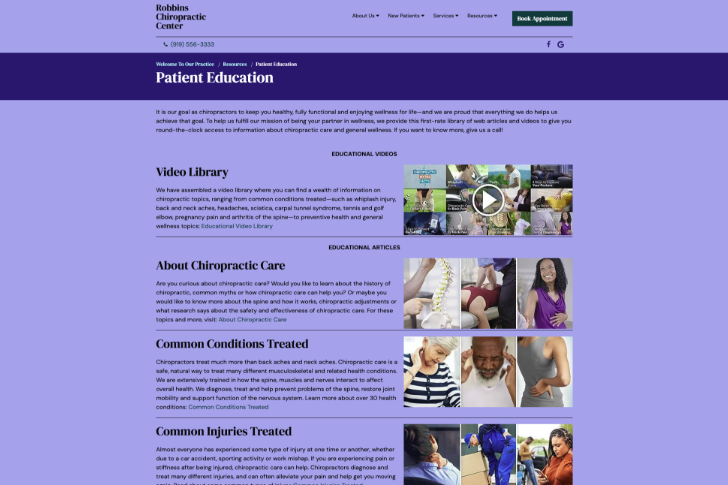
3: Robbins Chiropractic Center
Website: Robbins Chiropractic Center
Feature to Note
Robbins Chiropractic Center excels in patient education through its dedicated Patient Education Center. This section features a comprehensive library of web articles and videos, providing round-the-clock access to valuable information about chiropractic care and general wellness.
By offering educational resources on various conditions, treatments, and preventive measures, the website empowers patients with knowledge, helping them make informed decisions about their health. This focus on education not only builds trust but also positions the practice as a knowledgeable and reliable partner in patient wellness.
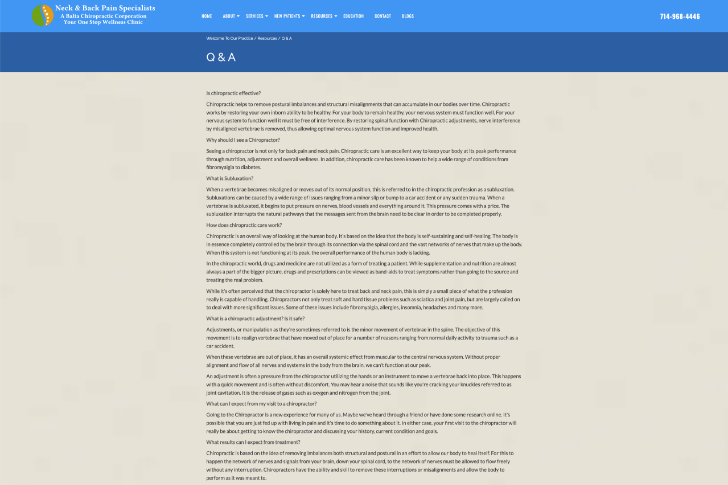
4: Neck & Back Pain Specialists
Website: Neck & Back Pain Specialists
Feature to Note
The Neck & Back Pain Specialists website features an in-depth Q&A section that addresses common patient questions comprehensively. This section provides detailed answers about chiropractic treatments, adjustments, and various conditions treated by the practice.
By offering thorough explanations, the Q&A section helps demystify chiropractic care, making it more accessible and understandable for potential patients. This focus on patient education builds trust and credibility, as it shows the practice’s commitment to transparency and patient empowerment.
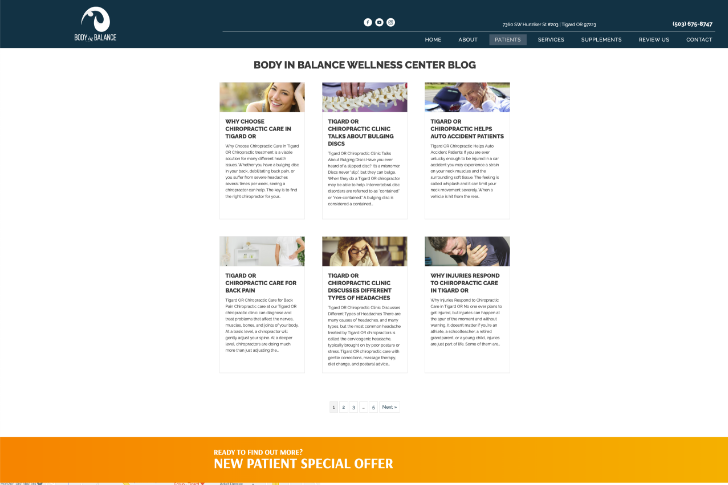
5: Body in Balance
Website: Body in Balance
Feature to Note
Body in Balance features an active blog section that regularly publishes articles on various health topics. This commitment to providing fresh, relevant content helps keep patients informed about chiropractic care, general wellness, and specific health issues.
By sharing knowledge through blog posts, the practice positions itself as a thought leader in the field, fostering a sense of community and engagement. This continuous flow of information not only educates patients but also enhances SEO, helping the website rank higher in search engine results and attract more visitors—a crucial element of online marketing.
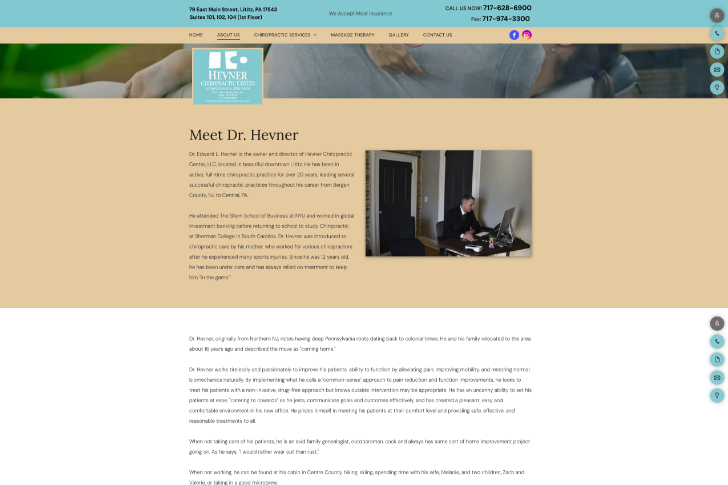
6: Hevner Chiropractic Center
Website: Hevner Chiropractic Center
Feature to Note
Hevner Chiropractic Center’s website features an in-depth “About Us” section that highlights the character and background of Dr. Edward L. Hevner. This section provides a comprehensive narrative about Dr. Hevner’s journey into chiropractic care, his professional philosophy, and his personal interests.
By sharing his story and values, the website design creates a personal connection with potential patients, making Dr. Hevner more relatable and trustworthy. This detailed portrayal helps to humanize the practice, fostering a sense of familiarity and comfort, which is crucial for building long-term patient relationships and attracting potential clients.
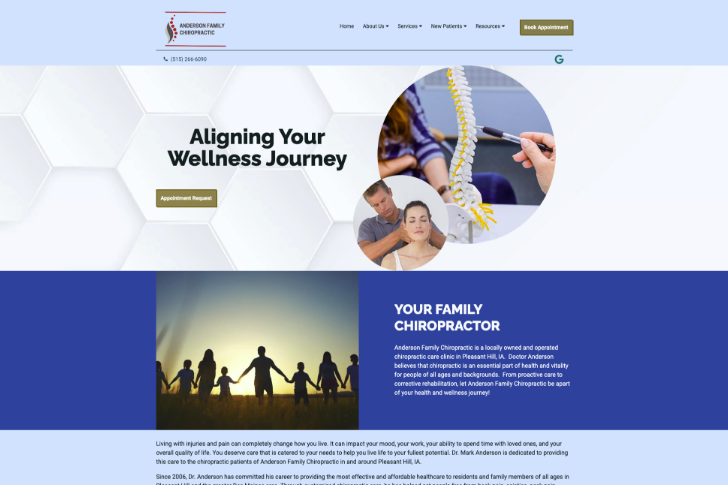
7: Anderson Family Chiropractic
Website: Anderson Family Chiropractic
Feature to Note
Anderson Family Chiropractic’s website features an extensive reviews section that showcases testimonials from satisfied patients. These firsthand accounts provide social proof of the quality of care offered by Dr. Anderson and his team.
By highlighting diverse experiences and positive outcomes, the reviews build trust and credibility, making potential patients feel more confident in choosing this practice. This transparency in showcasing patient feedback not only enhances the practice’s reputation but also demonstrates a commitment to patient satisfaction and continuous improvement.

8: Siniard Family Chiropractic
Website: Siniard Family Chiropractic
Feature to Note
Siniard Family Chiropractic’s website engages visitors with a captivating video on the homepage. This video integration provides an overview of the services offered and introduces Dr. James Siniard, creating a personal connection with potential patients.
Video content is a powerful tool for conveying information quickly and effectively, and it helps to humanize the practice by showcasing the friendly and professional environment—a great way to attract more patients. By using video, the practice can better capture the attention of visitors, increase engagement, and make a lasting impression.
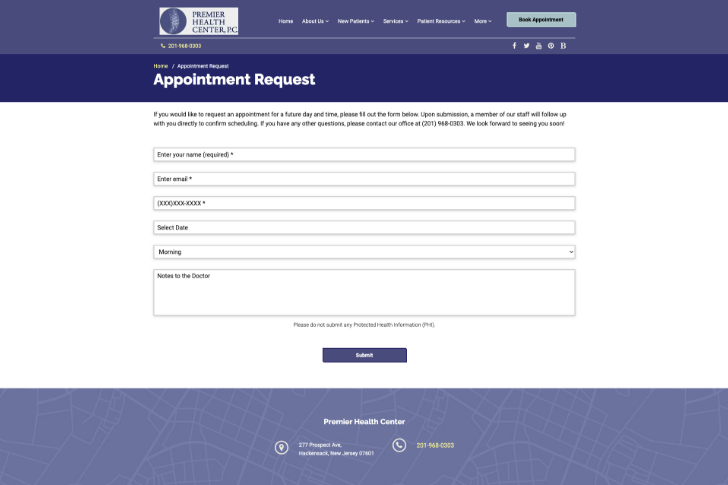
9: Premier Health Center
Website: Premier Health Center
Feature to Note
Premier Health Center’s website features an easy-to-use appointment request form that streamlines the process for patients to schedule their visits. By providing a straightforward and user-friendly form, the website ensures that potential patients can quickly and easily book appointments without the hassle of phone calls or emails.
This convenience enhances the user experience for patient receiving and can lead to higher conversion rates, as patients are more likely to complete the booking process when it is simple and accessible. The clear instructions and responsive design further contribute to a seamless and efficient appointment scheduling experience.
Best Practices for Patient-Focused Design in Chiropractic Websites
Understanding Your Patient’s Needs
Knowing your target audience is the first step in creating a patient-focused website. Understand their needs, preferences, and common concerns. Tailor the website content and design to address these aspects, ensuring that patients feel understood and valued.
Create your chiropractic site with an ideal patient persona in mind, a conglomeration of traits, needs, and wants of your best clients and potential clients you want to attract. Think about the chiropractic services they are looking for, the important elements that will resonate: a professional looking simple layout, attractive images, pleasing color scheme, testimonials section.
Using a persona can help guide you to your ideal potential client, and lead to more positive reviews because your marketing efforts are more focused to create and deliver a specific experience.
Prioritizing Accessibility
Accessibility is crucial for ensuring that all users, including those with disabilities, can navigate and use the website effectively. Implement features such as alt text for images, keyboard navigation, and screen reader compatibility to make the website accessible to everyone.
Color scheme, font choices, and design inspiration also become a very important way to convert visitors. It is important in an effort to stand out to still employ best practices for accessibility with these aesthetic elements. There are a number of free online tools to scan your website and flag any accessibility issues.
Using High-Quality Images
High-quality images can significantly enhance user engagement. Use professional images that reflect the practice’s environment, services, and staff. Avoid generic stock photos and opt for images that convey authenticity and professionalism.
A quality, compelling hero image (a full width hero image is ideal) gives your site credibility at first glance. Pair it with a clear and captivating headline and brief description to attract new clients, and introduce them to your various services. To view Online Chiro’s entire gallery of website templates specific to chiropractic practices, please fill out the form below.
View Our Website Designs & Packages
Keeping Content Updated
Regularly updating the website content is important for keeping it relevant, informative, and useful for search engine optimization. Ensure that information about services, staff, and contact details is up-to-date. Additionally, consider adding a blog section to share news, tips, and educational articles related to chiropractic care.
Quality, relevant content is a marker of the best chiropractic website, serving current and potential patients, placing in search engine rankings, and drawing more leads
Ensuring Fast Load Times
Website speed is a critical factor for user experience and SEO of any good website. Optimize images, use efficient coding practices, and leverage content delivery networks (CDNs) to ensure fast load times. A slow website can frustrate users and lead to higher bounce rates.
In addition to optimizing images and coding, consider minimizing the use of heavy scripts and plugins that can slow down your site. Regularly monitor your website’s performance using tools like Google PageSpeed Insights or GTmetrix to identify areas for improvement. Implementing these practices not only enhances user experience but also boosts your website’s search engine rankings, as search engines prioritize faster-loading websites.
Conclusion
A patient-focused chiropractic website design is essential for attracting and retaining patients. By enhancing user experience, building trust, and improving conversion rates, a well-designed website can significantly benefit a chiropractic practice. We hope these examples and best practices inspire you to evaluate your own website and implement patient-focused design elements.
At Online Chiro, we specialize in creating customized, patient-focused websites for chiropractic practices. In addition to being a website provider, our team of experts understands the unique needs of chiropractors and their patients, ensuring that every website we design not only looks great but also performs exceptionally well. We are a one-stop online marketing solution.
Whether you need a complete website overhaul or specific enhancements to your existing site, Online Chiro can help you achieve your goals and elevate your online presence.

Tiffany Beveridge is a seasoned writer and content strategist with over a decade of experience in creating compelling digital content. She believes access to affordable, premium chiropractic care should be available to all people, regardless of status. Tiffany enjoys being able to write content that helps grow chiropractic practices and make it more accessible to all patients.







